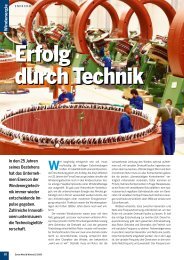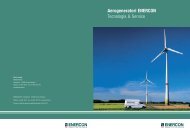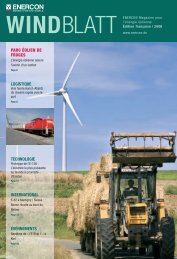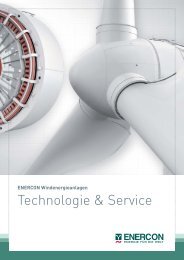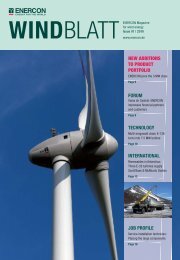Download - Enercon
Download - Enercon
Download - Enercon
You also want an ePaper? Increase the reach of your titles
YUMPU automatically turns print PDFs into web optimized ePapers that Google loves.
Australia<br />
10 WINDBLATT 04 | 2008 INTERNATIONAL<br />
3 x E-33 Wind farm on Ross Island<br />
Green energy for two<br />
Antarctic research stations<br />
Three E-33 turbines are currently underway to the Antarctic where they will arrive via New Zealand in<br />
February on board of the supply vessel “American Tern” on its annual voyage to McMurdo Sound. The turbines<br />
are intended to provide the research stations, Scott Base (New Zealand) and McMurdo (USA) on Ross<br />
Island, with environment-friendly electricity. Because the Antarctic “summer” is already drawing to a close<br />
by February, installation is scheduled to take place at the end of 2009/beginning of 2010 when a team of<br />
ENERCON engineers will build up the machines together with staff from Meridian Energy and Antarctica NZ.<br />
Situated 3000 kilometres from New Zealand’s<br />
South Island, ENERCON will be building<br />
the world’s southernmost wind farm for<br />
Meridian Energy Ltd (New Zealand’s largest<br />
electricity producer), backed up by the governmental<br />
organisation Antarctica New<br />
Brisbane<br />
Sydney<br />
Antarctica<br />
Mawson (Aus)<br />
South Pole<br />
New Zealand<br />
Wellington<br />
Christchurch<br />
Scott Base/McMurdo<br />
(Ross Island)<br />
From Scott Base, the distance to the pole is 1350 km.<br />
Source: NASA/Blue Marble<br />
Zealand (AntNZ) and with support from the<br />
US National Science Foundation (NSF). In the<br />
first stage, the wind power plant is predicted<br />
to reduce the need for fossil fuels at Scott<br />
Base and McMurdo by 11 %. Further WECs<br />
are scheduled to follow. By saving energy<br />
wherever possible and using renewable<br />
energy Meridian, AntNZ and NSF (responsible<br />
for McMurdo) are aiming at halving greenhouse<br />
gas emissions at both stations.<br />
“Both stations are closely linked – and not<br />
just by the longest road in the Antarctic<br />
(three kilometres)”, explains Andrea von<br />
Lindeiner, ENERCON sales rep for Australia,<br />
New Zealand, Central and South America.<br />
“The site at Crater Hill is situated on a<br />
mountain ridge just 1100 metres from Scott<br />
Base and only slightly over 1500 metres<br />
from McMurdo.” Meridian Energy and AntNZ<br />
will be operating the wind turbines. “Electricity<br />
produced will be shared between the<br />
two stations as part of an arrangement,<br />
whereby NSF and AntNZ share the logistical<br />
support requirements for the two.”<br />
ENERCON WECs are normally designed to<br />
withstand ambient temperatures ranging<br />
from -25 to +40° C. Von Lindeiner points<br />
out though that ENERCON wind turbines are<br />
already running extremely well at much lower<br />
temperatures, as the two E-30 machines<br />
at the Australian Antarctic station,<br />
Mawson base, have demonstrated. In comparison<br />
to the standard version, a few chan-<br />
ges have been made to the E-33 turbines<br />
destined for Ross Island.<br />
For instance, the towers are made of special<br />
low temperature resistant steel, the<br />
nacelle casing is thicker, the resistance of<br />
the cast components has been tested at extremely<br />
low temperatures, the control cabinets<br />
in the nacelle are heated and the PCBs<br />
in the electro-cabinets have been treated<br />
with a special varnish coating. The latter is<br />
done not really because of the climatic conditions<br />
on Ross Island, though. Although the<br />
air is cold there, it is actually very dry. “It’s<br />
actually because the sensitive PCBs have to<br />
be protected against the consequences of<br />
condensation which occurs during transport<br />
through the different climate zones across<br />
the globe”, explains von Lindeiner.<br />
Up until now diesel generators have<br />
been supplying both research stations on<br />
Ross Island with power. During the summer<br />
season, there are up to 1100 people, in<br />
McMurdo alone. A consumption of approx.<br />
4.5 million litres of diesel fuel is non-negligible<br />
and transporting the fuel to Ross<br />
Island’s harbour can be perilous as the period<br />
in which it is ice-free is quite short. “The<br />
Americans are upgrading their diesel generators<br />
and introducing systems to recover<br />
lost heat. Until now, a lot of the energy produced<br />
by the old generators was wasted”,<br />
explains Shaun Cornelius, the wind project<br />
development manager at Meridian. “These


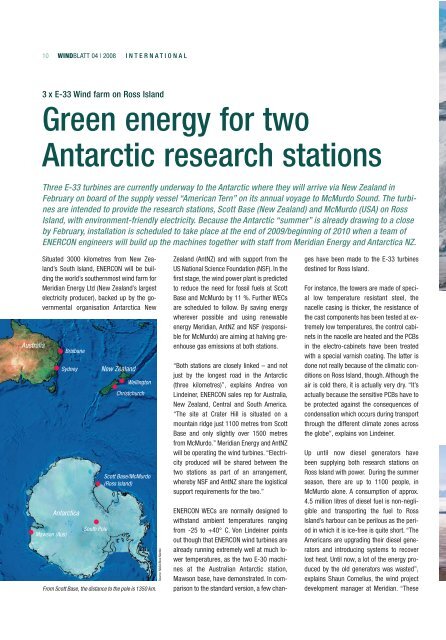
![[PDF] WB 02-2013 deu web - Enercon](https://img.yumpu.com/23394578/1/190x253/pdf-wb-02-2013-deu-web-enercon.jpg?quality=85)
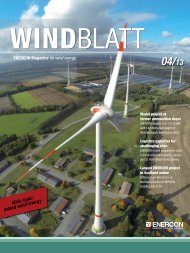

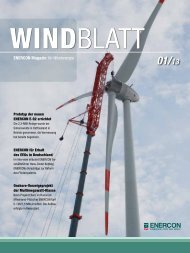
![[PDF] WB 04-2013 deu web - Enercon](https://img.yumpu.com/22304561/1/190x253/pdf-wb-04-2013-deu-web-enercon.jpg?quality=85)
